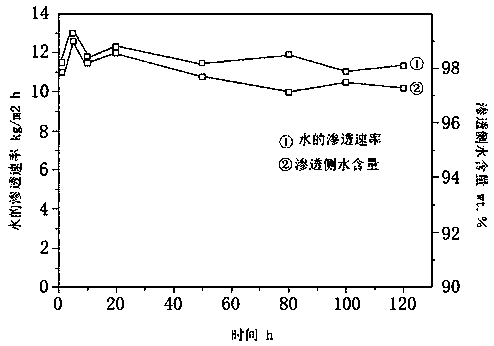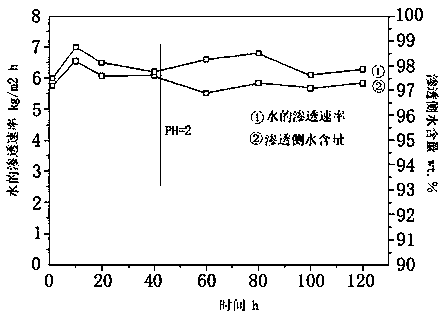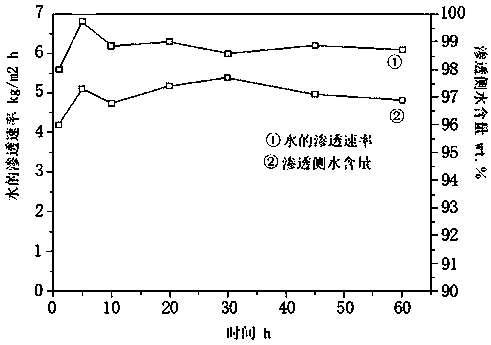Method for preparing organic-inorganic hybrid film
A hybrid membrane, inorganic technology, applied in chemical instruments and methods, membrane technology, semi-permeable membrane separation, etc. Easy to control and adjust, good acid resistance, avoid cracks or peeling effect
- Summary
- Abstract
- Description
- Claims
- Application Information
AI Technical Summary
Problems solved by technology
Method used
Image
Examples
Embodiment 1
[0030] A method for preparing an organic-inorganic hybrid membrane, specifically comprising the following steps:
[0031] Step 1: After diluting 10ml of methyltriethoxysilane (MTES) into absolute ethanol, gradually add 5ml of deionized water and 6ml of ammonia water (NH3.H2O, 37%) dropwise as a catalyst to adjust the pH of the hydrolysis. Heat the solution to 40-70°C while fully stirring, and stir vigorously at a constant temperature for 12 hours, let the solution fully hydrolyze and then drop to room temperature to form a sol solution with relatively single particle dispersion. The average particle size of the colloid is 4.8nm after analysis. ;
[0032] Step 2: Add a small amount of organic polymers, such as polyvinyl alcohol (PVA), to the sol solution to change the viscosity of the sol to 2.5-5.5Pa.s, and add an appropriate amount of plasticizer, such as polyethylene glycol (PEG), to adjust the plasticity of the sol;
[0033] Step 3: Apply the sol to the multi-layer suppor...
Embodiment 2
[0037]A method for preparing an organic-inorganic hybrid membrane, specifically comprising the following steps:
[0038] Step 1: After diluting 10ml of ethyltriethoxysilane (ETES) into absolute ethanol, gradually add 5ml of deionized water and 8ml of lysine (20wt.% aqueous solution) dropwise as catalysts to adjust the pH of the hydrolysis, Heat the solution to 40-70°C while fully stirring, and stir vigorously at a constant temperature for 8 hours to allow the solution to fully hydrolyze and then drop to room temperature to form a sol solution with relatively single particle dispersion. The average particle size of the colloid is 4.8nm after analysis. ;
[0039] Step 2: Add a small amount of organic polymers, such as polyvinyl alcohol (PVA), to the sol solution to change the viscosity of the sol to 2.5-5.5Pa.s, and add an appropriate amount of plasticizer, such as polyethylene glycol (PEG), to adjust the plasticity of the sol;
[0040] Step 3: Apply the sol to the multi-layer...
Embodiment 3
[0044] A method for preparing an organic-inorganic hybrid membrane, specifically comprising the following steps:
[0045] Step 1: After diluting 10ml of methyltriethoxysilane (MTES) into absolute ethanol, gradually dropwise add 5ml of deionized water and 30% acetic acid solution as a catalyst to adjust the pH of the hydrolysis, while fully stirring Heat the solution to 40-70°C, and stir vigorously at constant temperature for 16 hours, let the solution fully hydrolyze and then cool down to room temperature to form a sol solution with relatively single particle dispersion. The average particle size of the colloid is 4.8nm after analysis;
[0046] Step 2: Add a small amount of organic polymers, such as polyvinyl alcohol (PVA), to the sol solution to change the viscosity of the sol to 2.5-5.5Pa.s, and add an appropriate amount of plasticizer, such as polyethylene glycol (PEG), to adjust the plasticity of the sol;
[0047] Step 3: Apply the sol to the multi-layer support by dip co...
PUM
| Property | Measurement | Unit |
|---|---|---|
| The average particle size | aaaaa | aaaaa |
| Water permeability | aaaaa | aaaaa |
| Water permeability | aaaaa | aaaaa |
Abstract
Description
Claims
Application Information
 Login to View More
Login to View More - R&D
- Intellectual Property
- Life Sciences
- Materials
- Tech Scout
- Unparalleled Data Quality
- Higher Quality Content
- 60% Fewer Hallucinations
Browse by: Latest US Patents, China's latest patents, Technical Efficacy Thesaurus, Application Domain, Technology Topic, Popular Technical Reports.
© 2025 PatSnap. All rights reserved.Legal|Privacy policy|Modern Slavery Act Transparency Statement|Sitemap|About US| Contact US: help@patsnap.com



